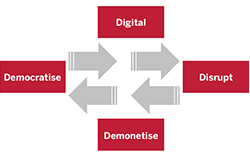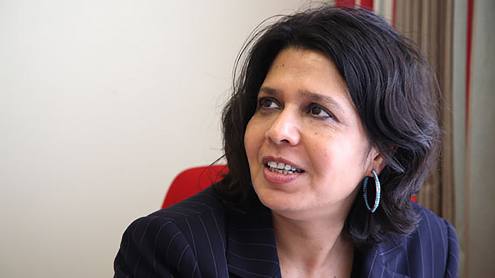I attended a meeting in Austria with Google recently. There were a number of Google Vision presentations and discussions. One slide particularly caught my attention, from Google’s creative evangelist Jeremy Abbett.

What it showed was that digitalisation eventually hits markets. When the technology is ripe, it disrupts those markets. Typically it means that markets lose value and become near-free. In other words, the technology rips out the profit and demonetises everything. Finally, free markets are in play, as the business model is democratised.
A Kodak moment?
The discussion was illustrated with reference to the industries that have been disrupted by technology: music, film, entertainment, travel and so on. In particular, we had a debate about the ‘Kodak moment’, at which technology destroys a business, and asked whether banks are heading for the same thing. Music has equally been hit by the democratisation of access through streaming, which means that it’s now tiny subscription-based services that generate income. Even entertainment is being turned on its head, as Netflix loses its film library and Amazon Prime pays top dollar for TV shows such as Top Gear.

I like the concept of these trends, although I can see some flaws when we apply this to banking. What the cycle should mean, if banking were like every other industry, is that technology is attacking the physical structure of banks and stripping the business model to pieces. It is. The next stage is that the margin in the traditional bank business model is then ripped away by start-ups. It is. Just look at peer-to-peer or payments to see that the products banks traditionally used to make margin are no longer viable.
But the democratisation of banking is not happening. This strikes at the heart of the libertarian dream: that banks and third parties can be removed from the value chain. They aren’t. It keeps coming back to the law and government licences, which give banks breathing space to adapt their models to the fintech disruption. This is why I believe another cycle is in play: the risk cycle. This cycle is similar to Google’s outline above, but subtly different.
To begin with, we see massive innovation that leads to disruption and new business models (the first two stages of the Google cycle). As companies emerge to tackle the incumbents, however, they create risk. Several of these new firms go bankrupt or work around the tight regulatory controls in place. As governments and policy-makers realise what is happening, they work fast to fill the gaps in their law-making structures. Think MtGox and Silk Road, but also think Uber. Uber is in that third cycle right now, as the incumbents fight back through the legal and regulatory system to shut it down or, at least, make it look more like the incumbents, with the same duties and responsibilities.
This is the dialogue most banks are having right now: how to make the upstarts work within the same constraints as the incumbents. This leads to a new level of compliance that is different to, but just as onerous as, the pre-existing market constraints. Then, of course, new players start to see gaps in the regulatory armour and begin to innovate once again.
I like these two models as they are brothers in arms. The difference is that you cannot democratise a tightly regulated market, only those that don’t matter to lawmakers.
Chris Skinner is an independent financial commentator and chairman of the London-based Financial Services Club.






